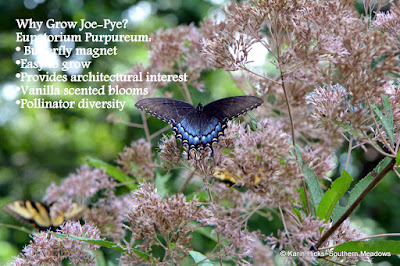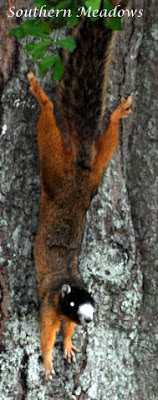Wildflower Wednesday: Eupatorium purpureum
By late August our Georgia garden tends to be rather weary from the heat, humidity and lack of rain. Most of our summer blooming perennials are past their peak and looking a bit worn, making Eupatorium purpureum a super star this time of year.
Commonly called Joe-Pye Weed, this herbaceous perennial is not a weed at all but a wonderful wildflower that is a favorite among many gardeners. Big and bold, growing up to 10 feet tall and 6 feet wide, it is a showstopper in moist meadows, native plant gardens and along roadsides. Eupatorium purpureum enhances our late summer, Zone 8 garden and transitions us seamlessly into fall.
Joe-Pye is a must have plant for a butterfly garden rich in native wildflower diversity. It fills the gap when many summer species are done flowering thus providing a rich food source for the many pollinators that thrive in our habitat garden. The mauve, vanilla scented flowers entice the insects to visit, luring them in to their sweet nectar. It is especially loved by swallowtail and monarch butterflies.
From the earliest morning light until the sun sets, Joe-Pye is blanketed in butterflies. It is an amazing sight to behold! Finding a monarch amongst the swallowtails is pure happiness. Monarchs are a rare sighting for us, particularly this time of year and we delight in their presence.
Eastern Tiger Swallowtails are abundant in our garden and as two of their host plants, tulip poplar and wild cherry tree, are plentiful in our woods it is only a short journey for the adult butterflies to the woodland edge ,where they can find a stand of Joe-Pye.
Native bees such as leaf-cutters, diggers and bumblebees tumble industriously around the umbles.
Other pollinators such as bee flies and skipper butterflies also frequently feed on the flowers.
I'm joining Wildflower Wednesday host, Gail at Clay and Limestone. Be sure to blog hop to see other fabulous wildflower growers.









.png)
